System Approach to the Process of Institutional Transformation for Industrial Integrations in the Digital Era
Abstract
:1. Introduction
2. Theoretical Analysis and Hypotheses Development
2.1. The Institutional Transformation of Industrial Integration
2.2. Institutional Platforms for Industrial Integration
2.3. Strategies for Developing Industrial Integrations
- Resource limitations that hinder the funding of strategic measures, the prompt implementation of new production projects, and corporate technological upgrades (including the implementation of modern digital services);
- Shortage of qualified staff and a lack of relevant competencies, especially in the field of digitalization, limiting the potential for reengineering most business processes in industrial systems and the adoption of new approaches to strategic development;
- Use of outdated management technologies and ineffective organizational structures that hinder the use of staff potential, the timely solution of complex cross-functional problems, and the achievement of strategic goals in a dynamically changing market environment;
- Low levels of development in innovation culture and corporate institutions, along with contradictory internal policies within top management.
3. Research Methodology
3.1. Logical Scenario Sequence of Institutional Transformations within Industrial Integrations
3.2. Structure of the Institutional Industrial Integration Platform
- (1)
- compliance platform for risk management;
- (2)
- digital platform;
- (3)
- functional platform;
- (4)
- process platform;
- (5)
- human resources platform;
- (6)
- organizational and structural platform;
- (7)
- institutional platform;
- (8)
- infrastructure platform.
- –
- individual strategic values grounded in shared values emphasizing the development and continuity of positive changes, production philosophy, digital culture, and a preference for innovative and experimental ideas;
- –
- formal norms, rules, and algorithms governing industrial relations, with the primary objective of providing a meaningful basis for establishing and developing effective institutions of industrial interaction;
- –
- informal practices of horizontal and network interactions that ensure flexibility in work processes, allowing for the mitigation of imperfections in regulations for implementing production procedures. These practices stimulate the development of cross-functional interaction among employees, fostering a dynamic exchange of experience, information, and innovative ideas within the framework of industrial integration;
- –
- technologies for managing and implementing work processes at industrial integration enterprises, delineating general approaches to organizing business processes and performing functions.
3.3. The Methodology for Assessing the Readiness of Industrial Systems to Implement Institutional Transformation Strategies
- (1)
- determining the level of readiness of the industrial system to implement the transformation strategy, which involves categorizing the readiness level as high, medium, or low based on established criteria;
- (2)
- identifying periods of decreased readiness of the industrial system, which is necessary for subsequently pinpointing and rectifying existing problems in the company’s development.
4. Results
- Most of the studied industrial systems possess the necessary resources to finance the transformation strategy and have infrastructure reserves (equipment, facilities, etc.) to optimize business processes and organize the production of new types of items. The exception is IS 12, which exhibits a low level of resource readiness to implement the strategy (55%);
- In terms of human resources, almost all the industrial systems under study show an average level of readiness to implement the transformation strategy. However, some of them face increased risks due to forced staff reductions. In 2023, noticeable staff reductions occurred at IS 7 (203 people, or 16.1% of the workforce) and IS 8 (99 people, or 46% of the workforce);
- The industrial systems under study display significant differentiation in terms of the readiness of the organizational structures to implement the strategy of institutional transformations. The most adaptive and communicative organizational structures are found in IS 6, IS 7, and IS 14. A low level of organizational readiness is noted in IS 4 (46%) and IS 11 (50%).
- None of the industrial systems studied exhibit a high level of readiness to implement transformation strategies in terms of the methodological tools and management technologies used. This is attributed to the fact that most manufacturing organizations have not fully realized the potential of using flexible management methods, introducing lean production technologies, and utilizing intelligent tools to support management decision making. Some manufacturers face challenges with the shifting of planned project deadlines, the underfunding of digital transformation activities, and the failure to solve other strategically significant problems.
- Most of the industrial systems under study perform at high and medium levels of readiness to implement strategies based on the state of corporate culture and institutions. The leaders include IS 14, IS 10, IS 7, and IS 6, which are characterized by a high level of staff involvement in the process of institutional reforms as well as staff loyalty. Some industrial systems (such as IS 1) have successfully developed diverse social and management institutions in production, forming an effective innovation-driven culture resistant to external crisis trends.
- The motivations used in the studied industrial systems incorporate financial and non-financial methods, covering the dominant part of their staff. However, these systems are often not customized. A high level of readiness to implement the change strategy from the perspective of the staff motivation system is observed in IS 5 (89%), IS 7 (85%), IS 14 (85%), and other industrial systems.
- 1.
- During 2023, almost all the industrial systems studied experienced a decline in the level of readiness to implement the transformation strategy. This decline can be attributed to crisis trends in the global and domestic economy and stemming from extensive sanctions. These factors resulted in staff reductions, decreased revenue and profit, sequestration of investments directed towards digitalization and technological upgrades, and a general destabilization across production, technological, financial, and other markets;
- 2.
- Based on the changes in the readiness level to implement the transformation strategy, the industrial systems can be categorized into three groups:
- -
- Businesses with high readiness: IS 7, IS 9, IS 14, IS 5, and IS 1 maintained a consistently high level of readiness. These businesses exhibit ongoing development, a sound financial standing, possess highly qualified staff, secure a significant number of government orders, address key sanctions issues, and actively pursue innovation in the digital economy;
- -
- Businesses with medium readiness: IS 2, IS 10, IS 13, IS 3, IS 4, IS 8, and IS 6 demonstrated an average level of readiness. They are implementing strategic measures for production upgrading and digital transformation, house a substantial number of qualified staff, participate in cluster structures, and engage in innovative projects;
- -
- Businesses with low readiness: IS 12 and IS 11 belong to this group.
- 3.
- To enhance the readiness level of industrial systems for strategy implementation and transformations, the following recommendations are suggested: creation of financial and material reserves, optimization of development project budgets, improvement of key staff skills, implementation of import substitution measures, enhancement of organizational structure flexibility, and the adoption of updated management methods. The advent of a digital economy amid a deteriorating international economic situation necessitates large-scale and dynamic reforms in the manufacturing sector.
5. Discussion
- –
- improve the efficiency of strategic management;
- –
- intensify innovation and integration processes;
- –
- accelerate digital transformation;
- –
- implement modern business models for enterprise development;
- –
- train administrative personnel for the industrial sectors.
6. Conclusions
Author Contributions
Funding
Data Availability Statement
Conflicts of Interest
Appendix A
| Assessed Resources | Assessment Criteria | The Procedure for Estimation of Readiness of the Industrial Systems According to the Relevant Criterion | Assessment of the Industrial Systems’ Readiness Level in Accordance with the Corresponding Criterion | |||
|---|---|---|---|---|---|---|
| L1—Low | L2—Medium | L3—High | ||||
| 1. Financial resources and production infrastructure | K1.1—The level of financial support for the strategy relative to target budget | K1.1 = (K1.1.1/K1.1.2) × 100%, where: K1.1.1—financial resources provided for the implementation of the strategy, K1.1.2—the target budget of the strategy | K1.1 ≤ 60% | 60% < K1.1 ≤ 80% | K1.1 > 80% | |
| K1.2—The level of infrastructural support of the strategy’s implementation in relation to the demand | K1.2 = K1.2.1 × N1.2.1 + K1.2.2 × N1.2.2 + K1.2.3 × N1.2.3 + K1.2.4 × N1.2.4 + K1.2.5 × N1.2.5, where: | K1.2 ≤ 50% | 50% < K1.2 ≤ 70% | K1.2 > 70% | ||
| K1.2.1—Necessary equipment availability for production program implementation, % demand | Weighing coefficient | |||||
| N1.2.1 = 0.3 | ||||||
| K1.2.2—Production space availability, % demand | N1.2.2 = 0.25 | |||||
| K1.2.3—Warehouse space availability, % | N1.2.3 = 0.2 | |||||
| K1.2.4—Land site availability, % | N1.2.4 = 0.15 | |||||
| K1.2.5—Transport facilities availability, % | N1.2.5 = 0.1 | |||||
| 2. Human resources | K2.1—Staffing level | K2.1 = (K2.1.1/K2.1.2) × 100%, where: K2.1.1—Number of positions on staff member list for the review period, units; K2.1.2—Total number of positions on staff member list of the industrial complex, persons | K2.1 ≤ 70% | 70% < K2.1 ≤ 85% | K2.1 > 85% | |
| K2.2—Personnel skill level | K2.2 = K2.2.1 × N2.2.1 + K2.2.2 × N2.2.2 + K2.2.3 × N2.2.3 + K2.2.4 × N2.2.4 + K1.2.5 × N1.2.5, where: | K2.2 ≤ 70% | 70% < K2.2 ≤ 85% | K2.2 > 85% | ||
| K2.2.1—Higher education rate among personnel, % | Weighing coefficient | |||||
| N2.2.1 = 0.15 | ||||||
| K2.2.2—Advanced training over the past 3-year rate among personnel, % | N2.2.2 = 0.1 | |||||
| K2.2.3—More than 5 years of professional experience rate among personnel, % | N2.2.3 = 0.15 | |||||
| K2.2.4—Usage of specialized software to solve work issues rate among personnel, % | N2.2.4 = 0.2 | |||||
| K2.2.5—Usage of advanced production technology rate among personnel, % | N2.2.5 = 0.4 | |||||
| 3. Organizational structures | K3.1—Communicativeness level of the organizational infrastructure | K3.2 = (K3.1.1 + K3.1.2 + K3.1.3)/3, where: | K3.1 ≤ 70% | 70% < K3.1 ≤ 80% | K3.1 > 80% | |
| K3.2.1—Level of information interaction between industrial systems personnel during horizontal communications, % | ||||||
| K3.2.2—Level of information interaction between industrial systems personnel during vertical communications, % | ||||||
| K3.2.3—Level of information interaction between industrial systems personnel and external contractors, % | ||||||
| K3.2—Adaptability level of the organizational infrastructure | K3.2 = (K3.2.1 + K3.2.2+ K3.2.3)/3, where: | K3.2 ≤ 50% | 50% < K3.2 ≤ 70% | K3.2 > 70% | ||
| K3.2.1—Presence of digitalization departments (formalized department—100%, informal department—50%, no department—0%). | ||||||
| K3.2.2—Presence of innovation and R&D departments (formalized department—100%, informal department—50%, no department—0%) | ||||||
| K3.2.3—Presence of project teams for cross-functional tasks (for most tasks—100%, for individual tasks—50%, no teams—0%). | ||||||
| 4. Methodical toolset and management technologies | K4.1—Level of advanced management techniques | K4.1 = K4.1.1 × N4.1.1 + K4.1.2 × N4.1.2 + K4.1.3 × N4.1.3 + K4.1.4 × N4.1.4+ K4.1.5 × N4.1.5, where: | K4.1 ≤ 50% | 50% < K4.1 ≤ 70% | K4.1 > 70% | |
| K4.1.1—Industrial complex strategic objectives with achievement plans (programs) in place, % | Weighing coefficient | |||||
| N4.1.1 = 0.2 | ||||||
| K4.1.2—Level of usage of flexible (project) management methods, % | N4.1.2 = 0.2 | |||||
| K4.1.3—Level of usage of lean management and production technologies, % | N4.1.3 = 0.2 | |||||
| K4.1.4—Industrial system departments with established key performance indicators (KPI), % | N4.1.4 = 0.15 | |||||
| K4.1.5—Digital technologies implementation level for management decision making, % | N4.1.5 = 0.25 | |||||
| K4.2—Quality and speed level of management decision making | K4.2 = K4.2.1 × N4.2.1 + K4.2.2 × N4.2.2 + K4.2.3 × N4.2.3 + K4.2.4 × N4.2.4, where: | K4.2 ≤ 65% | 65% < K4.2 ≤ 80% | K4.2 > 80% | ||
| K4.2.1—Timely management decisions, % | Weighing coefficient | |||||
| N4.2.1 = 0.3 | ||||||
| K4.2.2—Strategic plan milestones of the industrial complex implemented in accordance with the established deadlines, % per year | N4.1.2 = 0.25 | |||||
| K4.2.3—Strategic plan milestones of the industrial systems implemented in accordance with the established budgets, % per year | N4.1.3 = 0.25 | |||||
| K4.2.4—Field assignments from the management of the industrial systems implemented in accordance with the established deadlines and budgets, % per year | N4.1.4 = 0.2 | |||||
| 5. Corporate culture and institutions | K5.1—Personnel involvement in the transformation strategy | K5.1. = (K5.1.1 + K5.1.2+ K5.1.3 + K5.1.4)/4, where: | K5.1 ≤ 40% | 40% < K5.1 ≤ 60% | K5.1 > 60% | |
| K5.1.1—Personnel to be involved in implementation of the institutional transformation strategy, % | ||||||
| K5.1.2—Personnel to present new initiatives, ideas, and projects on the regular basis, % | ||||||
| K5.1.3—Personnel to participate in pilot projects, managerial and production experiments, % | ||||||
| K5.1.4—Personnel to participate in mentorship and experience transfer programs, % | ||||||
| K5.2—Personnel loyalty | K5.2. = (K5.2.1 + K5.2.2+ K5.2.3 + K5.2.4)/4, where: | K5.2 ≤ 70% | 70% < K5.2 ≤ 85% | K5.2 > 85% | ||
| K5.2.1—Personnel supporting the idea of institutional transformations at the industrial systems | ||||||
| K5.2.2—Personnel satisfied with the human resources policy of the industrial systems, % | ||||||
| K5.2.3—Personnel satisfied with internal norms and guidelines of the enterprise performance, % | ||||||
| K5.2.4—Customer-oriented employees in departments, interacting with external contractors, % | ||||||
| 6. Employee incentive program | K6.1—Coverage of employees by financial methods incentives | K6.1 = (K6.1.1/K6.1.2) × 100%, where: K6.1.1—Personnel with financial bonuses for successful implementation of transformation strategy, units K6.1.2—Average number of the industrial systems personnel, units | K6.1 ≤ 70% | 70% < K6.1 ≤ 85% | K6.1 > 85% | |
| K6.2—Non-financial motivation methods | K6.2 = (K6.2.1/K6.2.2) × 100%, where: K6.2.1—Personnel with non-financial motivation for successful implementation of transformation strategy, units K6.2.2—Average number of the industrial systems personnel, units | K6.2 ≤ 70% | 70% < K6.2 ≤ 85% | K6.2 > 85% | ||
References
- Greiner, L.E. Evolution and Revolution as Organizations Grow: A company’s past has clues for management that are critical to future success. Fam. Bus. Rev. 1997, 10, 397–409. [Google Scholar] [CrossRef]
- Adizes, I. Organizational passages—Diagnosing and treating lifecycle problems of organizations. Organ. Dyn. 1979, 8, 3–25. [Google Scholar] [CrossRef]
- Dorfman, J.C.E.; Ayres, N.W.; Chamberlain, S.K.; Gordon, R.A. Institutional Economics: Veblen, Commons, and Mitchell Reconsidered, 1st ed.; University of California Press: Berkeley, CA, USA, 1963. [Google Scholar] [CrossRef]
- Geoffrey, M.H. Thorstein Veblen and Socialism. J. Econ. 2023, 57, 1162–1177. [Google Scholar] [CrossRef]
- Hodgson, G.M. The Approach of Institutional Economics. J. Econ. Lit. 1998, 36, 166–192. [Google Scholar]
- Dugger, W.M.; Douglass, C. North’s New Institutionalism. J. Econ. Issues 1995, 29, 453–458. [Google Scholar] [CrossRef]
- Bates, R.H.; Sened, I.; Galiani, S. The New Institutionalism. The Work of Douglas North. In Institutions, Economic Growth, and Propety Rights: The Legacy of Douglass North; Cambridge University Press: Cambridge, UK, 2014. [Google Scholar]
- Breuning, M.; Ishiyama, J.T. Neoinstitutionalism. Encyclopedia Britannica, 28 October 2014. Available online: https://www.britannica.com/topic/neoinstitutionalism (accessed on 16 March 2024).
- Hodgson, G. On the Evolution of Thorstein Veblen’s Evolutionary Economics. Camb. J. Econ. 1998, 22, 415–431. [Google Scholar] [CrossRef]
- Faundez, J.D. North’s Theory of Institutions: Lessons for Law and Development. Hague J. Rule Law 2016, 8, 373–419. [Google Scholar] [CrossRef]
- Kleiner, G.B. The methodology of A. Bogdanov’s tektology in the context of modern systems economic theory. Syst. Res. Behav. Sci. 2023, 40, 393–406. [Google Scholar] [CrossRef]
- Boev, A.G. Typology of Institutional Transformation Strategies of Industrial Complexes in the Digital Economy. In Proceedings of the 2nd International Scientific and Practical Conference on Digital Economy (ISCDE 2020), Yekaterinburg, Russia, 5 November 2020. [Google Scholar]
- Kleiner, G. Business Ecosystem Strategy: Design and Specifics. Lect. Notes Netw. Syst. 2022, 442, 43–51. [Google Scholar] [CrossRef]
- Parman, J. The Inevitable: Understanding the 12 Technological Forces That Will Shape Our Future. Kevin Kelly Viking 2016, 114–115. [Google Scholar] [CrossRef]
- Fischer, M.M. The innovation process and network activities of manufacturing firms. In Innovation, Networks, and Knowledge Spillovers: Selected Essays; Springer: Berlin/Heidelberg, Germany, 2006; pp. 117–133. [Google Scholar]
- Dyatlov, S.A. Network effects and increasing returns in the information and innovation economy. Proc. St. Petersburg State Univ. Econ. 2014, 2, 7–11. [Google Scholar]
- Gamidullaeva, L.; Tolstykh, T.; Bystrov, A.; Radaykin, A.; Shmeleva, N. Cross-Sectoral Digital Platform as a Tool for Innovation Ecosystem Development. Sustainability 2021, 13, 11686. [Google Scholar] [CrossRef]
- Lipnack, J.; Stamps, J. The Age of the Network: Organizing Principles for the 21st Century; Oliver Wight Publications: Essex Junction, VT, USA, 1994. [Google Scholar]
- von Kardorff, E.C. The Rise of the Network Society. In Schlüsselwerke der Netzwerkforschung. Netzwerkforschung; Holzer, B., Stegbauer, C., Eds.; Springer: Wiesbaden, Germany, 2019. [Google Scholar] [CrossRef]
- Mata, A.S.d. Complex Networks: A Mini-review. Braz. J. Phys. 2020, 50, 658–672. [Google Scholar] [CrossRef]
- Ukko, J.; Nasiri, M.; Saunila, M.; Rantala, T. Sustainability Strategy as a Moderator in the Relationship between Digital Business Strategy and Financial Performance. J. Clean. Prod. 2019, 236, 25–43. [Google Scholar] [CrossRef]
- Verhoef, P.; Broekhuizen, T.; Bart, Y.; Bhattacharya, A.; Qi Dong, J.; Fabian, N.; Haenlein, M. Digital transformation: A multidisciplinary reflection and research agenda. J. Bus. Res. 2021, 122, 889–901. [Google Scholar] [CrossRef]
- Tolstykh, T.; Shmeleva, N.; Gamidullaeva, L.; Krasnobaeva, V. The Role of Collaboration in the Development of Industrial Enterprises Integration. Sustainability 2023, 15, 7180. [Google Scholar] [CrossRef]
- Li, L.; Liu, R.Z. Industrial Integration and High-quality Development of Manufacturing Industry: Based on Intermediary Effect of Collaborative Innovation. Econ. Surv. 2022, 39, 78–87. [Google Scholar]
- Zhou, M.S.; Zhang, Y.B. Does Digital Technology Promote the Integration of Manufacturing and Services? Sci. Technol. Prog. Policy 2022, 39, 74–82. [Google Scholar]
- Wang, F.B.; Zhong, J.; Liu, S. The Impact of Digital Transformation on the Servitization of Manufacturing: Theoretical Exploration and Experience Identification. Inq. Econ. Issues 2023, 7, 121–141. [Google Scholar]
- Matt, C.; Hess, T.; Benlian, A. Digital transformation strategies. Bus. Inf. Syst. Eng. 2015, 57, 339–343. [Google Scholar] [CrossRef]
- Chaparro-Pelaez, J.; Acquila-Natale, E.; Hernandez-García, A.; Iglesias-Pradas, S. The digital transformation of the retail electricity market in Spain. Energies 2020, 13, 2085. [Google Scholar] [CrossRef]
- Allen, R. Transformational and digital change: A UK perspective. Organ. Soc. Dyn. 2019, 19, 143–167. [Google Scholar] [CrossRef]
- Nadkarni, S.; Prügl, R. Digital transformation: A review, synthesis and opportunities for future research. Manag. Rev. Quart. 2021, 71, 233–341. [Google Scholar] [CrossRef]
- Hanelt, A.; Bohnsack, R.; Marz, D.; Antunes Marante, C. A systematic review of the literature on digital transformation: Insights and implications for strategy and organizational change. J. Manag. Stud. 2021, 58, 1159–1197. [Google Scholar] [CrossRef]
- Wang, S.; Song, Y.; Zhang, W. A Study on the Impact of Digital Transformation on Green Resilience in China. Sustainability 2024, 16, 2189. [Google Scholar] [CrossRef]
- Reis, J.; Melao, N. Digital transformation: A meta-review and guidelines for future research. Heliyon 2023, 9, e12834. [Google Scholar] [CrossRef] [PubMed]
- Broekhuizen, T.L.J.; Emrich, O.; Gijsenberg, M.J.; Broekhuis, M.; Donkers, B.; Sloot, L.M. Digital platform openness: Drivers, dimensions and outcomes. J. Bus. Res. 2019, 122, 902–914. [Google Scholar] [CrossRef]
- Parker, G.G.; Van Alstyne, M.W.; Choudary, S.P. Platform Revolution: How Networked Markets Are Transforming the Economy and How to Make Them Work for You; WW Norton & Company: New York, NY, USA, 2016. [Google Scholar]
- Frenken, K.; Vaskelainen, T.; Fünfschilling, L.; Piscicelli, L. An Institutional Logics Perspective on the Gig Economy. In Theorizing the Sharing Economy: Variety and Trajectories of New Forms of Organizing; Emerald Publishing Limited: Bingley, UK, 2020. [Google Scholar]
- Panori, A. Platforms Enhancing Proximity in the Digital Era. Platforms 2024, 2, 1–14. [Google Scholar] [CrossRef]
- Kenney, M.; Zysman, J. The platform economy: Restructuring the space of capitalist accumulation. Camb. J. Reg. Econ. Soc. 2020, 13, 55–761. [Google Scholar] [CrossRef]
- Kretschmer, T.; Leiponen, A.; Schil-ling, M.; Vasudeva, G. Platform ecosystems as metaorganizations: Implications for platform strategies. Strateg. Manag. J. 2022, 43, 405–424.13. [Google Scholar] [CrossRef]
- Li, H.; Yang, Z.; Jin, C.; Wang, J. How an industrial internet platform empowers the digital transformation of SMEs: Theoretical mechanism and business model. J. Knowl. Manag. 2023, 27, 105–120. [Google Scholar] [CrossRef]
- Loske, D.; Klumpp, M. Verifying the effects of digitalization in retail logistics: An efficiency centred approach. Int. J. Logist. Res. Appl. 2022, 25, 203–227. [Google Scholar] [CrossRef]
- Li, L.; Su, F.; Zhang, W.; Mao, J.Y. Digital transformation by SME entrepreneurs: A capability perspective. Inf. Syst. J. 2018, 28, 1129–1157. [Google Scholar] [CrossRef]
- Ghasemkhani, H.; Soule, D.; Westerman, G.F. Competitive Advantage in a Digital World: Toward an Information-Based View of the Firm. MIT Initiative on the Digital Economy. Working Paper. 2015; 25p. Available online: https://ssrn.com/abstract=2698775 (accessed on 1 March 2024).
- Pagani, M.; Pardo, C. The impact of digital technology on relationships in a business network. Ind. Mark. Manag. 2017, 67, 185–192. [Google Scholar] [CrossRef]
- Soule, D.L.; Carrier, N.; Bonnet, D.; Westerman, G.F. Organizing for a Digital Future: Opportunities and Challenges. MIT Center for Digital Business and Capgemini Consulting. Working Paper. 2014. 22p. Available online: https://ssrn.com/abstract=2698379 (accessed on 1 March 2024).
- Chandler, A.D. Strategy and Structure: Chapters in the History of the American Industrial Enterprise; The MIT Press: Cambridge, MA, USA, 1969; p. 480. [Google Scholar]
- Bennis, W.G.; Benne, K.D.; Chin, R. The Planning of Change; Holt, Rinehart, and Winston: New York, NY, USA, 1985; 487p. [Google Scholar]
- Kvint, V.L. Strategizing Societal Transformation. Knowledge, Technologies, and Noonomy; Kvint, V.L., Bodrunov, S.D., Eds.; Apple Academic Press: Palm Bay, FL, USA; Burlington, ON, Canada; Abingdon, UK, 2023; p. 228. [Google Scholar]
- Rumelt, R.P. Good Strategy/Bad Strategy; Crown Business: New York, NY, USA, 2016; p. 246. [Google Scholar]
- Barney, J.B.; Hesterly, W.S. Strategic Management and Competitive Advantage: Concepts and Cases, 5th ed.; Prentice Hall: Upper Saddle River, NJ, USA, 2010. [Google Scholar]
- The Report of KPMG’s Global Strategy Group. Digital Future: Economic Effect [Electronic Resource]. Available online: https://kpmg.com/xx/en/home/services/advisory/strategy.html (accessed on 11 December 2023).
- Drucker, P. Management Challenges for the 21st Century, 1st ed.; Routledge: London, UK, 2007; p. 208. [Google Scholar] [CrossRef]
- McKinsey Technology Trends Outlook 2022. [Electronic Resource]. Available online: https://www.mckinsey.com/capabilities/mckinsey-digital/our-insights/the-top-trends-in-tech-2022 (accessed on 20 November 2023).
- Muslim, R.; Syed, M.; Butt, M. Modified Shewhart Control Chart Based on CEV for Gamma Distributed Lifetimes in the Presence of Type-I Censored Data. J. Quant. Methods 2018, 2, 115–126. [Google Scholar] [CrossRef]
- Plečko, S.; Bradač Hojnik, B. Sustainable Business Practices and the Role of Digital Technologies: A Cross-Regional Analysis. Systems 2024, 12, 97. [Google Scholar] [CrossRef]
- Rachinger, M.; Rauter, R.; Müller, C.; Vorraber, W.; Schirgi, E. Digitalization and Its Influence on Business Model Innovation. J. Manuf. Technol. Manag. 2019, 30, 1143–1160. [Google Scholar] [CrossRef]
- Kalogiannidis, S.; Kalfas, D.; Chatzitheodoridis, F.; Kontsas, S. The Impact of Digitalization in Supporting the Performance of Circular Economy: A Case Study of Greece. J. Risk Financ. Manag. 2022, 15, 349. [Google Scholar] [CrossRef]
- Williams, A.; Kennedy, S.; Philipp, F.; Whiteman, G. Systems Thinking: A Review of Sustainability Management Research. J. Clean. Prod. 2017, 148, 866–881. [Google Scholar] [CrossRef]
- Chen, Y.; Sun, Z.; Wang, Y.; Ma, Y.; Yang, W. Seeds of Cross-Sector Collaboration: A Multi-Agent Evolutionary Game Theoretical Framework Illustrated by the Breeding of Salt-Tolerant Rice. Agriculture 2024, 14, 300. [Google Scholar] [CrossRef]
- Ferreira, J.J.M.; Fernandes, C.I.; Ferreira, F.A.F. To Be or Not to Be Digital, That Is the Question: Firm Innovation and Performance. J. Bus. Res. 2019, 101, 583–590. [Google Scholar] [CrossRef]
- Ruutu, S.; Casey, T.; Kotovirta, V. Development and competition of digital service platforms: A system dynamics approach. Technol. Forecast. Soc. Change 2017, 117, 119–130. [Google Scholar] [CrossRef]
- Kvint, V. The Global Emerging Market: Strategic Management and Economics; Routledge: New York, NY, USA, 2009; p. 488. [Google Scholar] [CrossRef]
- Zhu, Z.; Cui, S.; Wang, Y.; Zhu, Z. Exploration on the collaborative relationship between government, industry, and university from the perspective of collaborative innovation. Appl. Math. Nonlinear Sci. 2022, 7, 903–912. [Google Scholar] [CrossRef]
- Nurekenova, E.; Sholpanbayeva, K.; Apysheva, A.; Rakhimberdinova, M.; Shaikhanova, N. Assessment of the economic efficiency of industrial enterprise management during the Kazakhstan integration into the EAEU. Pol. J. Manag. Stud. 2022, 26, 233–249. [Google Scholar] [CrossRef]
- Babkin, A.; Tashenova, L.; Mamrayeva, D.; Shkarupeta, Y.; Pulyaeva, V.; Leifei, C. Digitalization of Industry in Russia and Kazakhstan: The Best Practices. Int. J. Technol. 2022, 13, 1568–1577. [Google Scholar] [CrossRef]
- Salnikov, V.A.; Gnidchenko, A.A.; Galimov, D.I. Industry-level effects from integration between Russia, Belarus, and Kazakhstan through industrial cooperation. Stud. Russ. Econ. Dev. 2016, 27, 101–113. [Google Scholar] [CrossRef]
- Liu, H.; Xu, C.; Lim, G. The China effect on regional economic integration: A longitudinal study of Central, South, and Southeast Asia. J. Asia Pac. Econ. 2023, 1–23. [Google Scholar] [CrossRef]
- Lu, J.; Gao, Y.F.; Wang, T.X. The impact of regional economic integration on China’s manufacturing industry: A simulation analysis based on RCEP. J. Soochow Univ. 2021, 3, 124–135. [Google Scholar] [CrossRef]
- Müller, J.M.; Islam, N.; Kazantsev, N.; Romanello, R.; Olivera, G.; Das, D.; Hamzeh, R. Barriers and Enablers for Industry 4.0 in SMEs: A Combined Integration Framework. IEEE Trans. Eng. Manag. 2024; 1–13. [Google Scholar] [CrossRef]
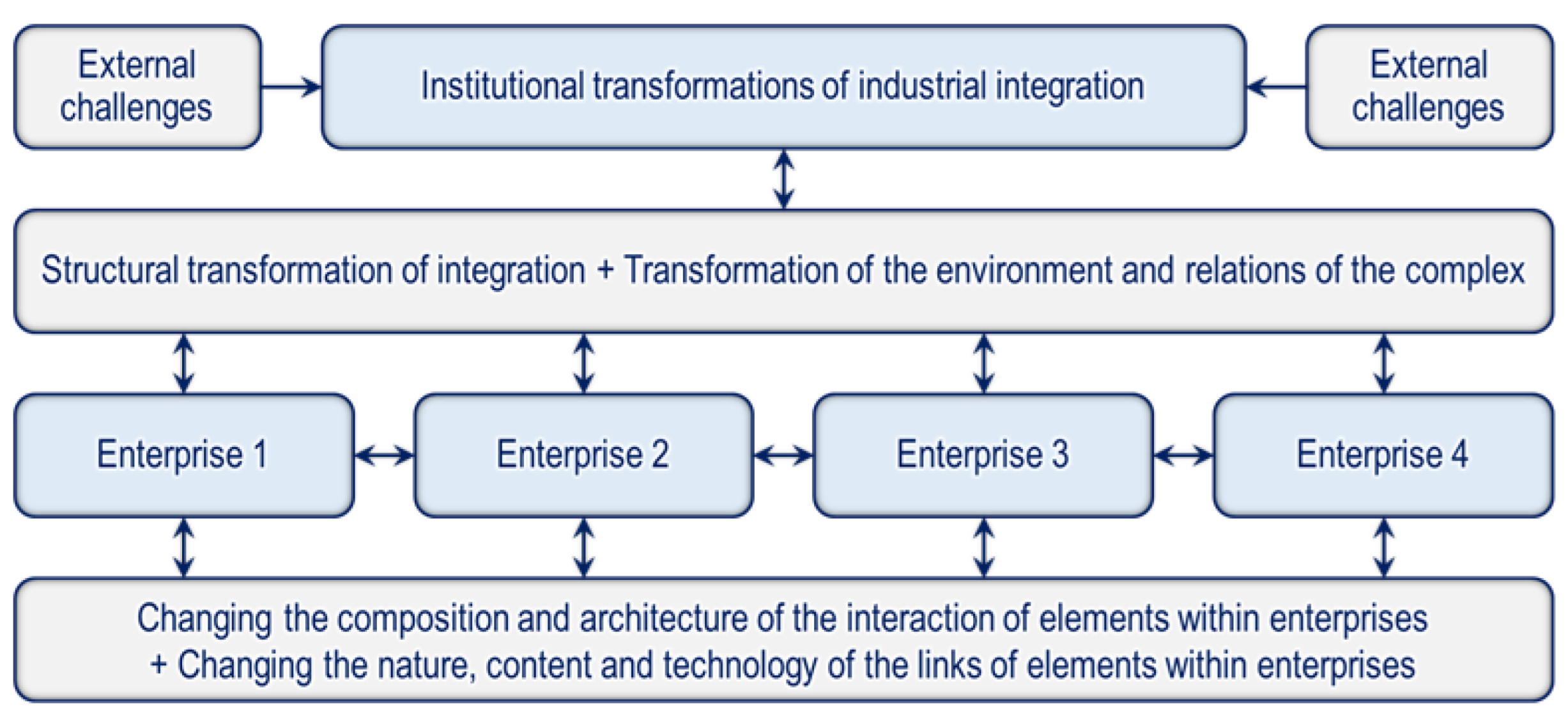
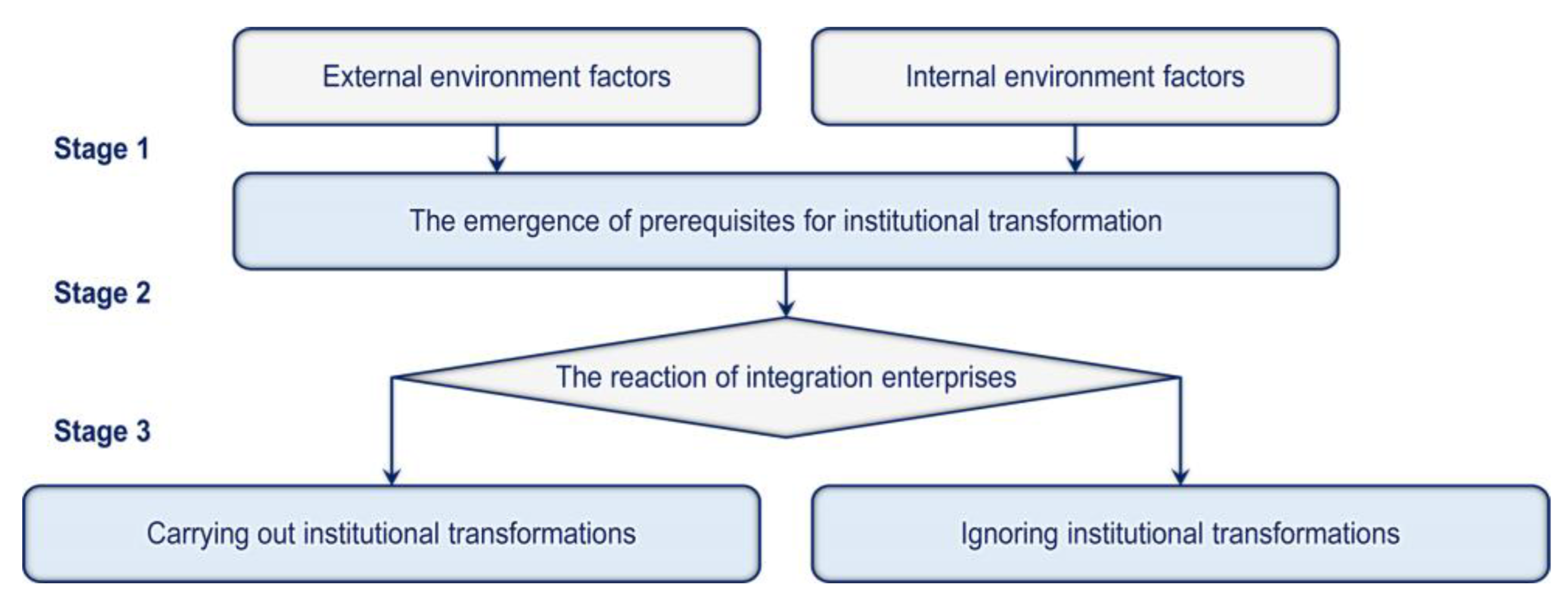



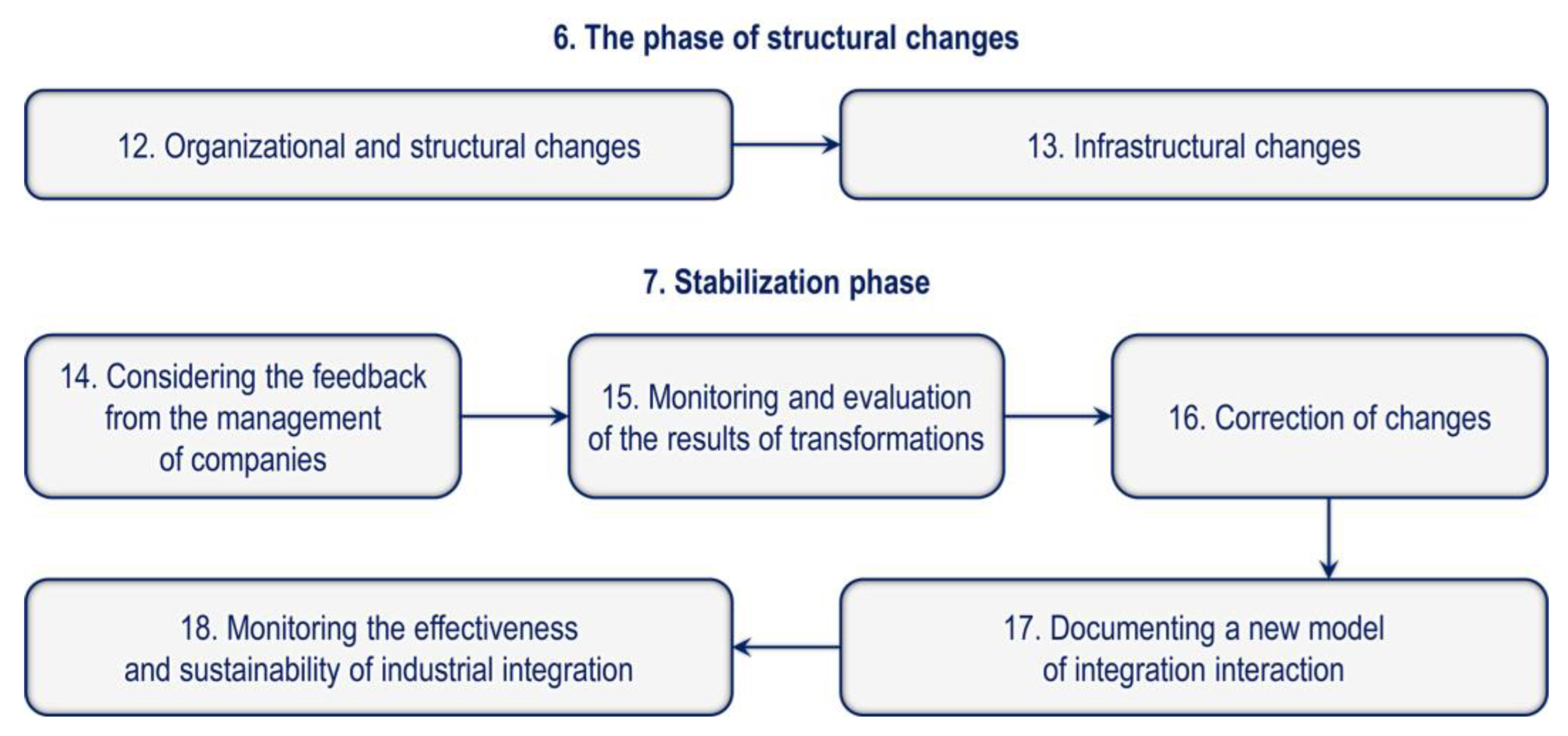
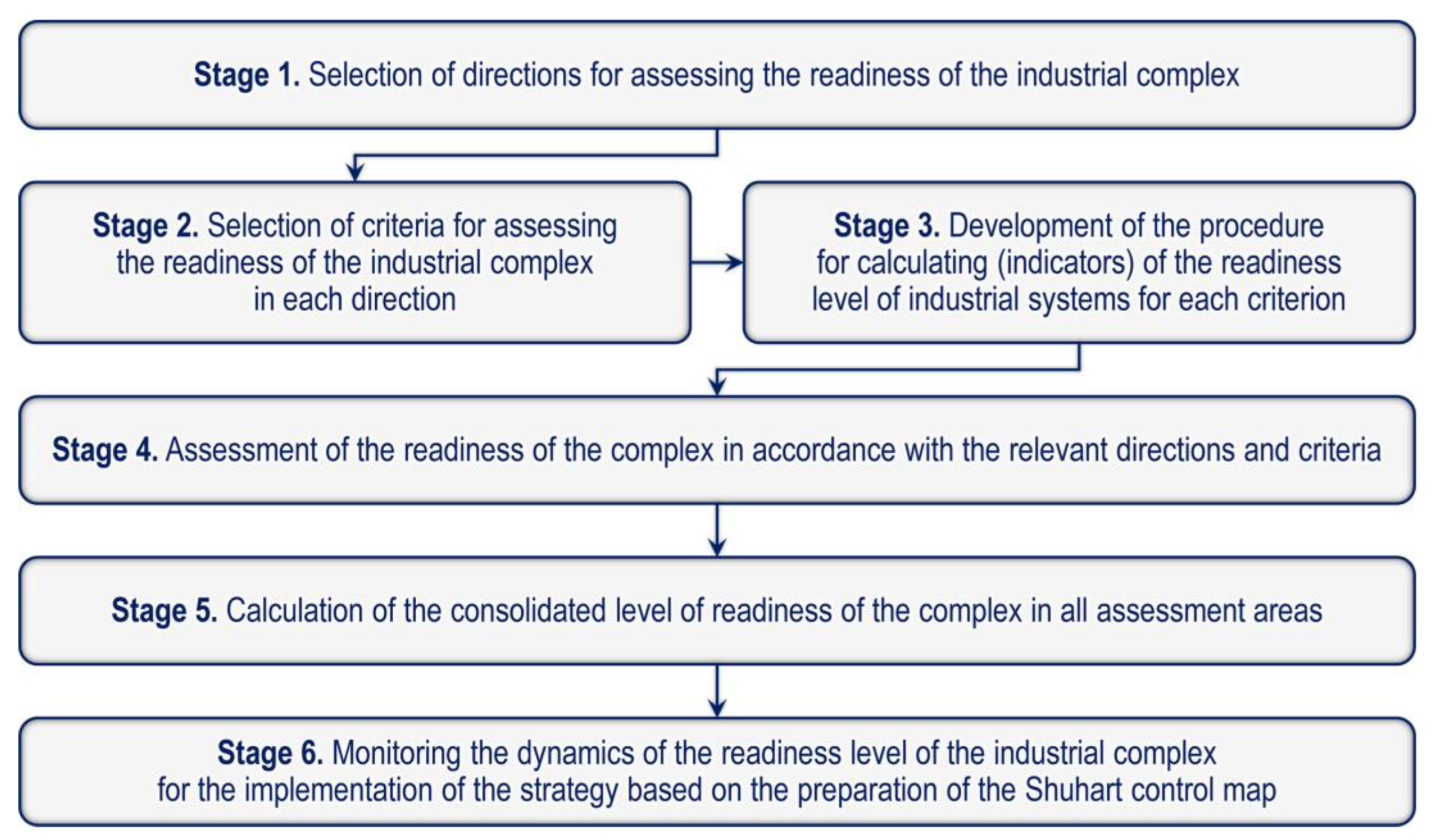

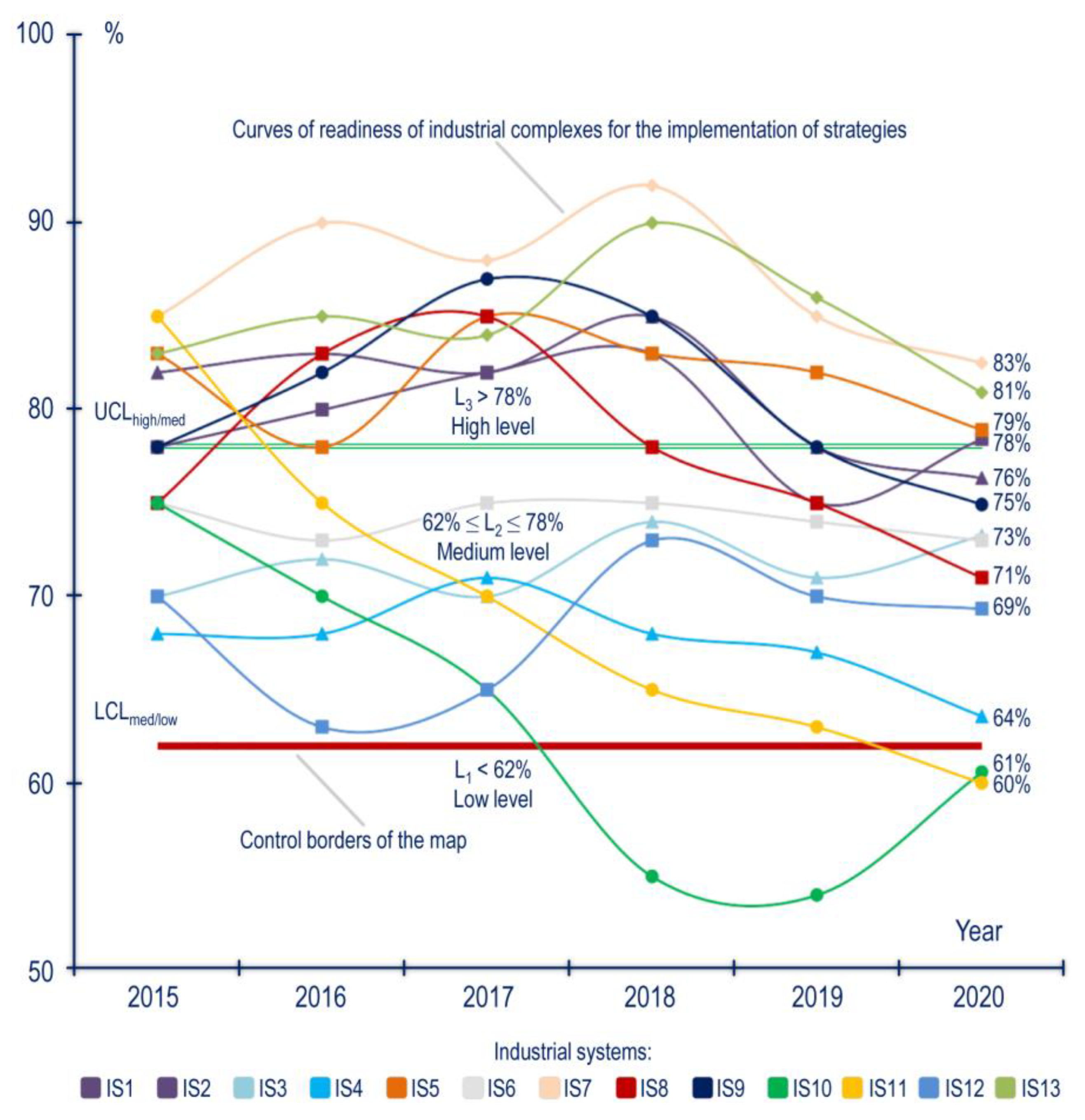
| Criteria | IS 1 | IS 2 | IS 3 | IS 4 | IS 5 | IS 6 | IS 7 | IS 8 | IS 9 | IS 10 | IS 11 | IS 12 | IS 13 | IS 14 |
|---|---|---|---|---|---|---|---|---|---|---|---|---|---|---|
| K1.1 | 84% | 80% | 82% | 68% | 89% | 61% | 90% | 60% | 91% | 77% | 68% | 42% | 73% | 85% |
| K1.2 | 81% | 75% | 67% | 78% | 77% | 63% | 90% | 61% | 82% | 78% | 80% | 68% | 65% | 75% |
| K2.1 | 85% | 82% | 83% | 80% | 81% | 79% | 92% | 83% | 85% | 79% | 73% | 77% | 75% | 82% |
| K2.2 | 83% | 75% | 75% | 68% | 86% | 72% | 78% | 75% | 77% | 70% | 67% | 75% | 71% | 83% |
| K3.1 | 72% | 70% | 72% | 52% | 69% | 86% | 85% | 74% | 85% | 79% | 55% | 61% | 70% | 80% |
| K3.2 | 82% | 81% | 64% | 39% | 73% | 82% | 87% | 68% | 67% | 55% | 45% | 51% | 63% | 84% |
| K4.1 | 73% | 75% | 70% | 57% | 69% | 55% | 70% | 60% | 71% | 79% | 50% | 53% | 61% | 79% |
| K4.2 | 75% | 73% | 65% | 59% | 78% | 62% | 75% | 63% | 63% | 71% | 60% | 43% | 72% | 77% |
| K5.1 | 64% | 72% | 70% | 48% | 69% | 76% | 75% | 65% | 70% | 72% | 45% | 55% | 71% | 69% |
| K5.2 | 82% | 73% | 75% | 69% | 78% | 77% | 78% | 82% | 70% | 82% | 67% | 65% | 68% | 87% |
| K6.1 | 74% | 72% | 73% | 67% | 88% | 78% | 84% | 84% | 85% | 74% | 45% | 63% | 73% | 82% |
| K6.2 | 86% | 88% | 83% | 78% | 90% | 88% | 86% | 81% | 90% | 83% | 72% | 72% | 70% | 88% |
| Kis (total) | 78% | 76% | 73% | 64% | 79% | 73% | 83% | 71% | 78% | 75% | 61% | 60% | 69% | 81% |
Disclaimer/Publisher’s Note: The statements, opinions and data contained in all publications are solely those of the individual author(s) and contributor(s) and not of MDPI and/or the editor(s). MDPI and/or the editor(s) disclaim responsibility for any injury to people or property resulting from any ideas, methods, instructions or products referred to in the content. |
© 2024 by the authors. Licensee MDPI, Basel, Switzerland. This article is an open access article distributed under the terms and conditions of the Creative Commons Attribution (CC BY) license (https://creativecommons.org/licenses/by/4.0/).
Share and Cite
Tolstykh, T.; Shmeleva, N.; Boev, A.; Guseva, T.; Panova, S. System Approach to the Process of Institutional Transformation for Industrial Integrations in the Digital Era. Systems 2024, 12, 120. https://doi.org/10.3390/systems12040120
Tolstykh T, Shmeleva N, Boev A, Guseva T, Panova S. System Approach to the Process of Institutional Transformation for Industrial Integrations in the Digital Era. Systems. 2024; 12(4):120. https://doi.org/10.3390/systems12040120
Chicago/Turabian StyleTolstykh, Tatyana, Nadezhda Shmeleva, Alexey Boev, Tatiana Guseva, and Svetlana Panova. 2024. "System Approach to the Process of Institutional Transformation for Industrial Integrations in the Digital Era" Systems 12, no. 4: 120. https://doi.org/10.3390/systems12040120






